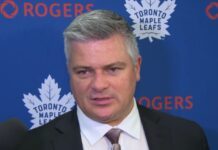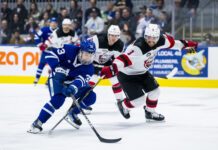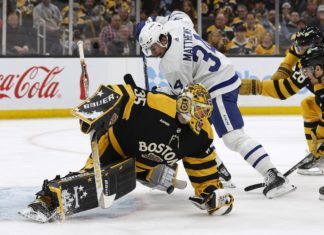What a much more enjoyable month of hockey that was from the Maple Leafs, the latter half in particular. Toronto has seven regulation wins in their last 10 games, and are 9-1-1 in their last 11, after just seven regulation wins total between October 29 and January 14. The Leafs seem to be playing closer to the potential their talent level would suggest after a couple of bleak months culminating in a brief stint spent on the outside looking in at a playoff spot.
Saturday’s win was the first game of the season in which the Leafs out shot an opponent by 10 or more. It also represented a rare occasion in which the Leafs won with a save percentage below .900, as Jonathan Bernier stopped 88.5% of 26 shots (lol Senators).
They’re still far from the finish line, however, and the goal has to be improvement down the stretch and into the playoffs. There’s also merit to the adage (which I’m making up a variation to right now), “you’re not as good as you think when you’re winning a lot, and you’re not as bad as you think when you’re losing a lot.” We know why the Leafs are winning games right now, and it’s the scorching hot play of their top six, set for the foreseeable future as JvR – Bozak – Kessel/Lupul – Kadri – Kulemin. So, let’s take a look at the bottom six.
Looking just at the short term – the very immediate future – it would be helpful if Peter Holland’s lace bite injury healed up quickly. Bolland, Smith, and Holland all being out limits the options for the bottom six, and Ashton being out doesn’t help, either. Jerred Smithson was recalled this morning, with Greg McKegg returned to the Marlies. A two-line team works when the two lines are blazing hot, which they are and it’s been awesome, but the Leafs will need some depth contributions at some point.
Time On Ice Among Forwards
Let’s take a step back from the minutiae of the current injury situation among the lower roster for a minute.
While looking into the time on ice numbers for the Leafs forwards relative to the League, it’s notable that the Leafs have three forwards with 20 or more minutes of ice time – their top line of James van Riemsdyk, Phil Kessel, and Tyler Bozak. There is only one other team in the League with three forwards with 20 or more minutes of ice time, which is the Vancouver Canucks with Ryan Kesler and the Sedins. These six players comprise six of the top 25 in the League in time on ice per game among forwards.
My concern is less to do with Kessel’s line playing a few seconds extra every night. The more apprehensive among us might express concern about the extra few shifts a night possibly wearing this line out down the stretch, given two-thirds of it will be at the Olympics and it plays about 2 minutes more per game than, say, the Senators top line from Saturday night. But this Leafs top line is in the class of Getzlaf and Perry’s line and Crosby and Kunitz’s, all four of whom play pretty much the same kind of minutes (within a few seconds, anyway) as the members of the Leafs’ top line.
Moving down the roster, we see the likes of Lupul, Kadri and Raymond in the 17 and a half to 18 minute range, and the Leafs with more regular forwards north of the 16 minute mark than usual. What about Kadri, for instance, playing his first full 82-game season in the NHL and starting to push toward the 18 minute mark of late?
As far as game situations, could this tie into why the Leafs struggle to close out periods and games? It’s been better lately, but it’s unquestionably been a serious issue over the course of the season. The Leafs have conceded more third period goals than any other team in the League (64). There has been much talk about the Leafs’ passivity to their systems, and yet an insistence from the coaching staff in their interviews that nothing changes in terms of the directions from behind the bench. Could the team be tiring late in periods and late in games?
Putting aside the fatigue question for a second, there needs to be some flexibility in the minutes depending on the temperature of the game. Every team will have periods, if not full games, where their skilled group is just not getting it done. We saw this happen over some extended stretches in November and December. Hopefully we won’t see dips in production to the same extent from all of JvR, Kessel, Kadri and Lupul (they seemed to arrive at the same time when the Leafs were really struggling), but there will be games where this is going to be the case down the stretch. Carlyle needs effective energy lines that can grab some momentum, spend some time in the right end of the rink, and occasionally grind out a goal when highlight reel goals from the top 6 aren’t in the offing. Bolland returning to line three could be a boon for the depth of this team, especially if Clarkson plays better next to him, and even Holland next to Bodie and Raymond looked to be a decent interim solution on line three.
This has been a long winded way of arriving at a seemingly obvious point. The fourth line can also be a part of this. We all know why the Leafs’ time on ice is allocated the way it is: Randy Carlyle barely uses his fourth line. This is made all the more obvious when we look at time-on-ice data across the league.
Fourth Line Usage
Here’s a chart on the quantity of players, with a minimum of 10 games played, averaging less than 7 minutes on each team.
Quantity of Players with >10GP who average less than 7 minutes per game
| Teams | less than 7 TOI/g |
|---|---|
| ANA | 0 |
| BOS | 0 |
| BUF | 1 |
| CGY | 3 |
| CAR | 1 |
| CHI | 0 |
| COL | 2 |
| CLB | 0 |
| DAL | 0 |
| DET | 1 |
| EDM | 1 |
| FLA | 1 |
| LA | 0 |
| MIN | 1 |
| MTL | 1 |
| NAS | 0 |
| NJ | 1 |
| NYI | 1 |
| NYR | 0 |
| OTT | 1 |
| PHI | 1 |
| PHX | 1 |
| PIT | 0 |
| SJ | 0 |
| STL | 0 |
| TBL | 1 |
| TOR | 3 |
| VAN | 2 |
| WSH | 0 |
| WPG | 2 |
Let’s pare that down to 6 minutes, again with a minimum of ten games played.
Quantity of Players with >10GP who average less than 6 minutes per game
| Teams | less than 6 |
|---|---|
| ANA | 0 |
| BOS | 0 |
| BUF | 0 |
| CGY | 1 |
| CAR | 0 |
| CHI | 0 |
| COL | 1 |
| CLB | 0 |
| DAL | 0 |
| DET | 0 |
| EDM | 0 |
| FLA | 0 |
| LA | 0 |
| MIN | 0 |
| MTL | 1 |
| NAS | 0 |
| NJ | 1 |
| NYI | 0 |
| NYR | 0 |
| OTT | 1 |
| PHI | 1 |
| PHX | 1 |
| PIT | 0 |
| SJ | 0 |
| STL | 0 |
| TBL | 0 |
| TOR | 2 |
| VAN | 0 |
| WSH | 0 |
| WPG | 1 |
Now, let’s look at a minimum of 20 games played for players under 7 minutes.
Quantity of Players with >20GP who average less than 7 minutes per game
| Team | Less than 7 |
|---|---|
| ANA | 0 |
| BOS | 0 |
| BUF | 1 |
| CGY | 1 |
| CAR | 0 |
| CHI | 0 |
| COL | 1 |
| CLB | 0 |
| DAL | 0 |
| DET | 0 |
| EDM | 1 |
| FLA | 1 |
| LA | 0 |
| MIN | 0 |
| MTL | 1 |
| NAS | 0 |
| NJ | 1 |
| NYI | 0 |
| NYR | 0 |
| OTT | 1 |
| PHI | 1 |
| PHX | 1 |
| PIT | 0 |
| SJ | 0 |
| STL | 0 |
| TBL | 0 |
| TOR | 3 |
| VAN | 1 |
| WSH | 0 |
| WPG | 1 |
17 out of 30 teams do not have a player who has appeared in more than 20 games and averaged less than 7 minutes of ice. 12 teams have one player who has appeared in more than 20 games and averaged less than 7 minutes of ice. There are zero teams with exactly two players that match this description. The Leafs have three.
Let’s contrast the records of the teams who roll their lines more with those who do it less:
Records of teams with no players below 7 minutes per game (min 10GP)
| Team | W | L | OTL/SOL |
|---|---|---|---|
| ANA | 40 | 12 | 5 |
| BOS | 35 | 16 | 3 |
| CHI | 33 | 10 | 14 |
| CLB | 28 | 23 | 4 |
| DAL | 25 | 21 | 9 |
| LA | 30 | 21 | 6 |
| NAS | 25 | 23 | 9 |
| NYR | 30 | 23 | 3 |
| PIT | 38 | 15 | 2 |
| SJ | 35 | 15 | 6 |
| STL | 37 | 12 | 5 |
| WSH | 25 | 22 | 9 |
| Total | 381 | 213 | 75 |
| Pts Percentage | 0.663 |
Records of teams with one or more players below 7 minutes per game (min. 10GP)
| Team | W | L | OTL/SOL |
|---|---|---|---|
| BUF | 15 | 31 | 8 |
| CGY | 21 | 27 | 7 |
| CAR | 25 | 20 | 9 |
| COL | 35 | 14 | 5 |
| DET | 24 | 19 | 12 |
| EDM | 18 | 33 | 6 |
| FLA | 21 | 27 | 7 |
| MIN | 29 | 21 | 7 |
| MTL | 29 | 21 | 6 |
| NJ | 23 | 21 | 12 |
| NYI | 21 | 28 | 8 |
| OTT | 24 | 21 | 10 |
| PHI | 27 | 23 | 6 |
| PHX | 26 | 19 | 10 |
| TBL | 32 | 18 | 5 |
| TOR | 30 | 21 | 6 |
| VAN | 27 | 20 | 9 |
| WPG | 27 | 25 | 5 |
| Total | 454 | 409 | 138 |
| Pts Percentage | 0.561 |
Interesting note: The Penguins, even with Crosby playing 21+ minutes, Kunitz close to 20 and Malkin on the second line, do not have a single player below 10 minutes in average TOI.
This isn’t all that revelatory. The suggestion here is not that the magic solution in Calgary is to simply roll their lines more. Obviously, the coaches who do roll four lines do it because they have to depth to pull it off. And that’s the thing – the Leafs have the depth to pull it off.
When a few bodies return to the lineup, this team has the pieces in Trevor Smith, Carter Ashton, Jay McClement, Troy Bodie and Jerry D’Amigo to piece together a solid fourth line that can play a healthy amount of minutes, provide energy on the forecheck, keep the pace up (as Carlyle puts it, “the feet moving”), and chip in the odd goal. Having Colton Orr around, but not always in the lineup, could have its benefits in certain situations. I didn’t view the Orr situation in high dudgeon as some did dating back to early last season, but the issue is that so few players seem to engage Orr this year; that, or he is content serving an energy role for the team with the encouragement of the coaching staff. In terms of energy over enforcement, though, there are far better options.
The coaching staff obviously feels differently about Orr’s game, and a big part of that could be the view that Orr’s presence provides a deterrent. That could be true; we’re not privy to the chirping between the benches and on the ice, or how the Leaf players themselves might feel about Orr’s presence, I don’t know, fortifying the backbone to their group.
Of course, this isn’t a new argument whatsoever about the 4th line usage, and the Leaf coaching staff seem entrenched in their policy of “one enforcer always, and sometimes two.” But this discussion will resurface yet again when it’s decision time in regards to the bottom six, with Clarkson, Smith and Bolland all set to return soon. Some tough decisions will be need to made in terms of who to demote and, potentially, who to waive.
It may be a pipe dream at this point, but a four-line approach with the newfound depth of options could give the Leafs an additional edge as they look to play their best hockey down the stretch and into the playoffs.

































